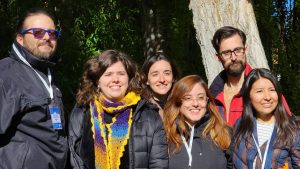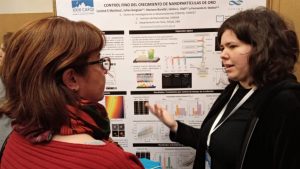Members of the applied nanophysics laboratory of the Bionanoscience Research Center (CIBION) attended the XXIII Argentine Congress of Physicochemistry and Inorganic Chemistry. The event was held from April 11 to 14, 2023, in the city of El Calafate, Santa Cruz.

The topics of the event included different areas of physical chemistry, at the same time that researchers groups from different parts of the country presented to the academic community the scientific advances of their and collaborative works.
Luciana Martínez, a doctoral fellow at this institute, gave a talk on how to optimize the printing of gold nanostars and presented a poster on light-assisted growth of gold nanoparticles. Florencia Choque, also a doctoral fellow, presented a technique developed in the laboratory called p-MINFLUX: it is a tool to follow ultra-fast individual molecules.

Luciana Martínez, becaria doctoral

Florencia Choque, becaria doctoral
Meanwhile, doctoral fellow Gonzalo Escalante showed a poster in which he explained how the STORM super-resolution technique is being applied to the study of Trypanosoma Cruzi. In turn, Florencia Edorna, another of the doctoral fellows, presented the super-resolution technique developed in the RASTMIN laboratory.

Gonzalo Escalante, becario doctoral
On the other hand, the poster presented by Luis Fernando Marcano García, also a CIBION doctoral fellow, referred to trying to determine the equilibrium constant of thermodynamic association of proteins in cells from the spots of bright spots measured by fluorescence microscopy .

Luis Fernando Marcano García, becario doctoral
Finally, the researcher Ianina Lucila Violi gave a semi-plenary talk on the latest advances in the manufacture of nanoparticle arrays obtained by optical printing, used as a platform for the study of light-assisted reactions at the individual particle level.